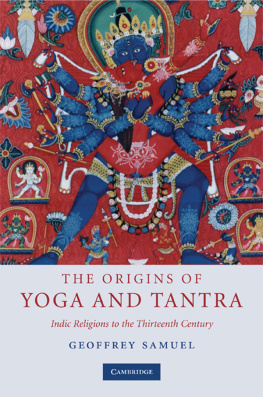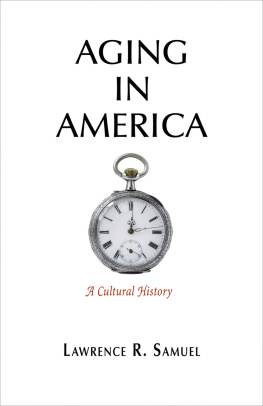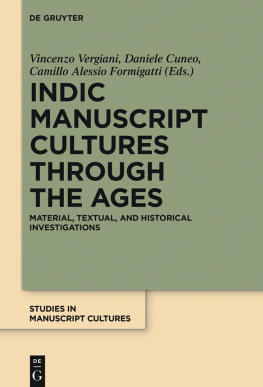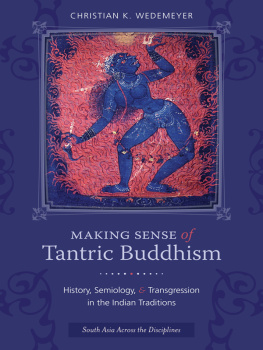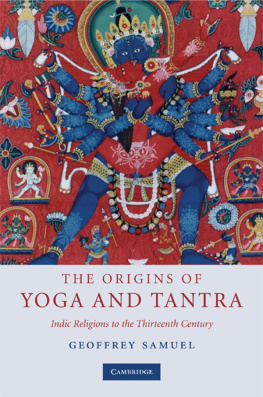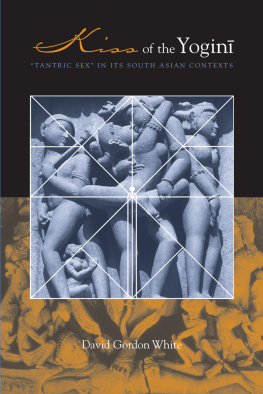THE ORIGINS OF YOGA AND TANTRA
Yoga, Tantra and other forms of Asian meditation are practised in modernised forms throughout the world today, but most introductions to Hinduism or Buddhism tell only part of the story of how they developed. This book is an interpretation of the history of Indic religions up to around 1200 CE, with particular focus on the development of yogic and Tantric traditions. It assesses how much we really know about this period, and asks what sense we can make of the evolution of yogic and Tantric practices, which were to become such central and important features of the Indic religious scene. Its originality lies in seeking to understand these traditions in terms of the total social and religious context of South Asian society during this period, including the religious practices of the general population with their close engagement with family, gender, economic life and other pragmatic concerns.
GEOFFREY SAMUEL is Professorial Fellow at the School of Religious and Theological Studies at Cardiff University. His publications include Mind, Body and Culture: Anthropology and the Biological Interface (2006).
CAMBRIDGE UNIVERSITY PRESS
Cambridge, New York, Melbourne, Madrid, Cape Town, Singapore, So Paulo, Delhi
Delhi, Dubai, Tokyo, Mexico City
Cambridge University Press
The Edinburgh Building, Cambridge CB2 8RU, UK
Published in the United States of America by Cambridge University Press, New York
www.cambridge.org
Information on this title: www.cambridge.org/9780521695343
Geoffrey Samuel 2008
This publication is in copyright. Subject to statutory exception
and to the provisions of relevant collective licensing agreements,
no reproduction of any part may take place without
the written permission of Cambridge University Press.
First published 2008
Reprinted 2010
Printed in the United Kingdom at the University Press, Cambridge
A catalogue record for this publication is available from the British Library
Library of Congress Cataloging-in-Publication Data
Samuel, Geoffrey.
The origins of yoga and tantra: Indic religions to the thirteenth century /
Geoffrey Samuel.
p. cm.
Includes bibliographical references and index.
ISBN 978-0-521-87351-2 (hardback) ISBN 978-0-521-69534-3 (pbk.)
1. IndiaReligion. 2. YogaHistory. 3. TantrismHistory. I. Title.
BL2005.S26 2008
294.0901dc22 2007046053
ISBN 978-0-521-87351-2 Hardback
ISBN 978-0-521-69534-3 Paperback
Cambridge University Press has no responsibility for the persistence or
accuracy of URLs for external or third-party internet websites referred to
in this publication, and does not guarantee that any content on such
websites is, or will remain, accurate or appropriate.
Contents
Figures
To my wife and fellow-scholar
Santi Rozario
who inspired this book and without whose help and
support it would never have been written
Preface
This book is based on the Wilde Lectures in Natural and Comparative Religion, which I delivered at the University of Oxford in November and December 2002 under the title Indic religions to 1200 AD: a critical and anthropological approach. Those who were present at the lectures will realise that this book differs from the lectures in other respects besides the title. Most of the text of the lectures is here, in one form or another, but I have taken the opportunity to rethink and extend the argument in many places. Unfortunately, the extensive visual material presented in the lectures has had for practical reasons mostly to be excluded from the book.
This is a relatively short book, however, on a very large subject, and there has been no attempt to be comprehensive. The book focuses on the development of the yogic and Tantric tradition in Indic societies, and while I have discussed the wider context in which these events happened in considerable detail, I have not attempted to provide a comprehensive history of Indian religion.
It is difficult to deal with language transcription consistently and systematically in a book that ranges over several bodies of scholarly literatures with different conventions. The omission of diacritics is nevertheless a major irritant and often deprives the reader of vital information, quite apart from rendering it impossible to know how words might be pronounced. My general strategy has been to give only modern place names and words that are thoroughly Anglicised without diacritics. I have generally given Sanskrit forms in preference to Pali or other Prakrits, though have employed the latter in contexts where it would seem clumsy or inappropriate to do otherwise (e.g. when I am citing the Pali Canon). I beg the reader's indulgence for remaining errors and inconsistencies; I am not a Sanskritist.
I wish to express my appreciation to the Electors of the Wilde Lectures for allowing me to give the lectures, and in particular to Richard Gombrich, who was a most kind and gracious host during my stay in Oxford, as indeed during my previous stay in 1999, and who helped me in very many respects in relation to this book. I would also wish to thank those who attended the lectures and provided valuable discussion and insight, and to many others with whom I have discussed some or all of these issues in recent years. The list is a long one, but I wish to mention at least Naman Ahuja, Nick Allen, Robert Beer, Jim Benson, Marieke Clarke, Lance Cousins, Max Deeg, Gill Farrer-Halls, Gavin Flood, Will Tuladhar-Douglas, David Gellner, Sanjukta Gupta, Adam Hardy, James Hegarty, Saunaka Rishi Das, Will Johnson, Klemens Karlsson, Kim Chong-Ho, Elizabeth de Michelis, Mogg and Kym Morgan, Ruth Rickard, Rob Mayer, Cathy Cantwell, Brian Bocking, Kate Crosby, Brenda McGregor, Ted Proferes, Robert Pryde, Julia Shaw, Andrew Skilton and Michael Willis. I apologise to others whom I have undoubtedly omitted. I particularly thank Thomas J. Hopkins for his graciousness in allowing me to read and refer to his unpublished work on the early history of Indian religions, Gunnar Haaland for allowing me to use a photograph of a thang-ka in his possession for the cover, and Rob Linrothe, Theresa McCullough, Mark Nichter, Asko Parpola, Sylvia Sax and Anne Vergati for providing photographs and for assistance in obtaining permission to use photographs. I also thank the National Museum of India, the Department of Archaeology and Museums, Government of Pakistan, for permission to use images and Peshawar Museum, Vidisha Museum, and the Indian Museum, Calcutta for permission to photograph objects in their collections. I thank Kate Brett, Gillian Dadd, Jodie Barnes and Sarah Barnes, of Cambridge University Press, for their friendly, helpful and efficient assistance with producing the book.
I also thank the University of Newcastle, New South Wales for allowing me to undertake two periods of study leave during which much of the research for the book was undertaken, the Leverhulme Trust and Brian Bocking for a visiting professorship at the School of Oriental and African Studies in 20034 which gave time for valuable further work on this project, and Cardiff University for appointing me to the Professorial Fellowship which has allowed its completion. I also wish to acknowledge the participants in the May 2004 workshop at SOAS on the politics of Asian religions, among them Saunaka Rishi Das, Madhu Kishwar, Rajiv Malhotra, Hiroko Kawanami, Chakraborty Ram Prasad and Ursula King, who helped greatly in formulating some of the ideas in and elsewhere in the book. I do not think that at this point in time there is any fully satisfactory answer to the questions raised on that occasion, but I hope that this book will be in its way a positive contribution to the ends towards which that workshop was directed.

